Welcome to the ultimate guide for preparing a truly delightful and incredibly easy Tzimmes recipe! This cherished Jewish holiday dish, traditionally a hearty stew, has been reimagined into a simple, healthy, and vibrant side that’s perfect for any occasion. Forget the fuss and embrace the flavor with this vegan version, roasted on a single sheet pan for minimal cleanup. Whether you’re celebrating Rosh Hashanah, Passover, Sukkot, or simply enjoying a Shabbat dinner, this pareve (meat-free) Tzimmes promises to be a delicious and nourishing addition to your table.
I’ve taken the essence of classic Tzimmes – the comforting sweetness of caramelized onions, juicy prunes, and tender sweet potatoes and carrots – and streamlined it for the modern kitchen. The result is a fall-apart tender, naturally sweet, and utterly satisfying dish that brings tradition and health together in perfect harmony. Are you ready to dive into a Tzimmes recipe that’s as effortless as it is exquisite?
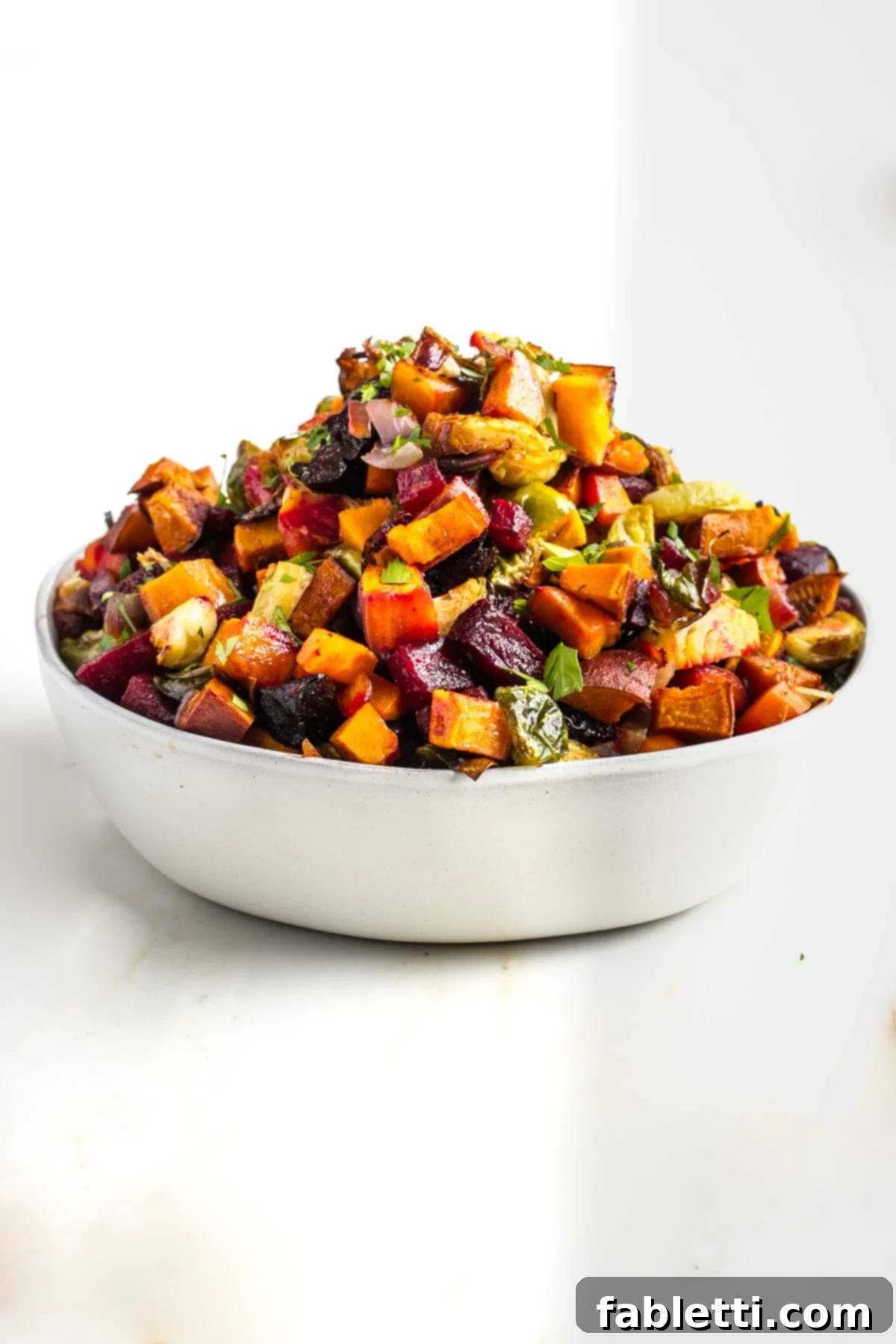
What is Tzimmes? Unpacking the Sweet Tradition
The word “Tzimmes” (pronounced Tsi-miss) is Yiddish, originally meaning “a big fuss over something.” This culinary term perfectly captures the sentimental value and effort traditionally poured into preparing this dish for Jewish holidays. My grandmother, for instance, would indeed make a “tzimmes” over her holiday cooking, ensuring every detail was perfect. This familial connection, deeply rooted in tradition, is why Tzimmes holds such a special place in my heart and on our holiday table.
Historically, Tzimmes was a simple vegetable stew, evolving over time into the sweeter, often meat-inclusive dish many recognize today. For the Jewish New Year, Rosh Hashanah, sweet foods like Tzimmes are symbolic. They represent our hopes and prayers for a sweet, prosperous year ahead. While traditional recipes might include roast chicken drippings, stew meat, brown sugar, and honey, my approach focuses on preserving the symbolic sweetness and comforting essence through healthy, plant-based ingredients. I find that the natural caramelization of starchy vegetables combined with dried fruits provides ample sweetness, honoring the tradition without needing excessive added sugars or animal products.
My goal with this recipe is to adapt and evolve, ensuring that beloved traditions remain accessible and enjoyable for everyone. I believe in creating dishes that evoke cherished childhood memories without demanding so much time and effort that the joy of cooking for loved ones is lost. This easy Tzimmes recipe is a testament to that philosophy, earning its place not only at a festive holiday meal but also as a staple in my healthy, vegan kitchen.
Looking to start the Jewish New Year off with healthy and delicious recipes? No Jewish holiday is complete without an abundance of yummy food. Check out my roundup of Healthy Rosh Hashanah Recipes to add something new to your menus this year.
Why This One-Pan Tzimmes Will Become Your Go-To Recipe
In today’s fast-paced world, everyone appreciates shortcuts, especially when it comes to preparing wholesome meals. While I can’t offer a shortcut for the extensive cleaning associated with Passover – a process best embraced as a time for turning inward and reflection, speaking from experience! – I certainly have insights into simplifying Jewish holiday cooking and everyday meals. This Tzimmes recipe is my delicious “shortcut” to a healthy and satisfying dish.
Wholesome, real food doesn’t typically require complex preparations or trips through a drive-thru. Simplicity often triumphs in terms of time management, taste, nutrition, and budget. For the traditionalists among you who might scoff at calling this quick and healthy version “authentic Tzimmes,” I invite you to consider that adaptation is, in itself, a form of tradition. The essence of Tzimmes – sweet, nourishing, and communal – is beautifully preserved and even enhanced in this modern interpretation, proving that innovation can honor heritage.
This recipe transforms the classic into a vibrant, sheet-pan wonder. By roasting all the ingredients together, you not only achieve a delightful medley of caramelized flavors but also simplify the cooking process and, crucially, the cleanup. This one-pan method ensures that the vegetables develop a rich, sweet crust, enhancing their natural flavors without the need for simmering in heavy syrups or fats. It’s a method that truly allows the ingredients to shine, delivering a Tzimmes that is both lighter and intensely flavorful, proving that healthy can indeed be incredibly delicious.
Essential Ingredients & Savvy Substitutions for Your Perfect Tzimmes
Creating the perfect Tzimmes involves a harmonious blend of root vegetables and dried fruits, accented by aromatic spices. While traditional recipes often center around carrots and sweet potatoes, this modern version incorporates a few non-traditional elements that enhance flavor, texture, and nutritional value. Each ingredient is carefully chosen to contribute to the dish’s overall balance and deliciousness.
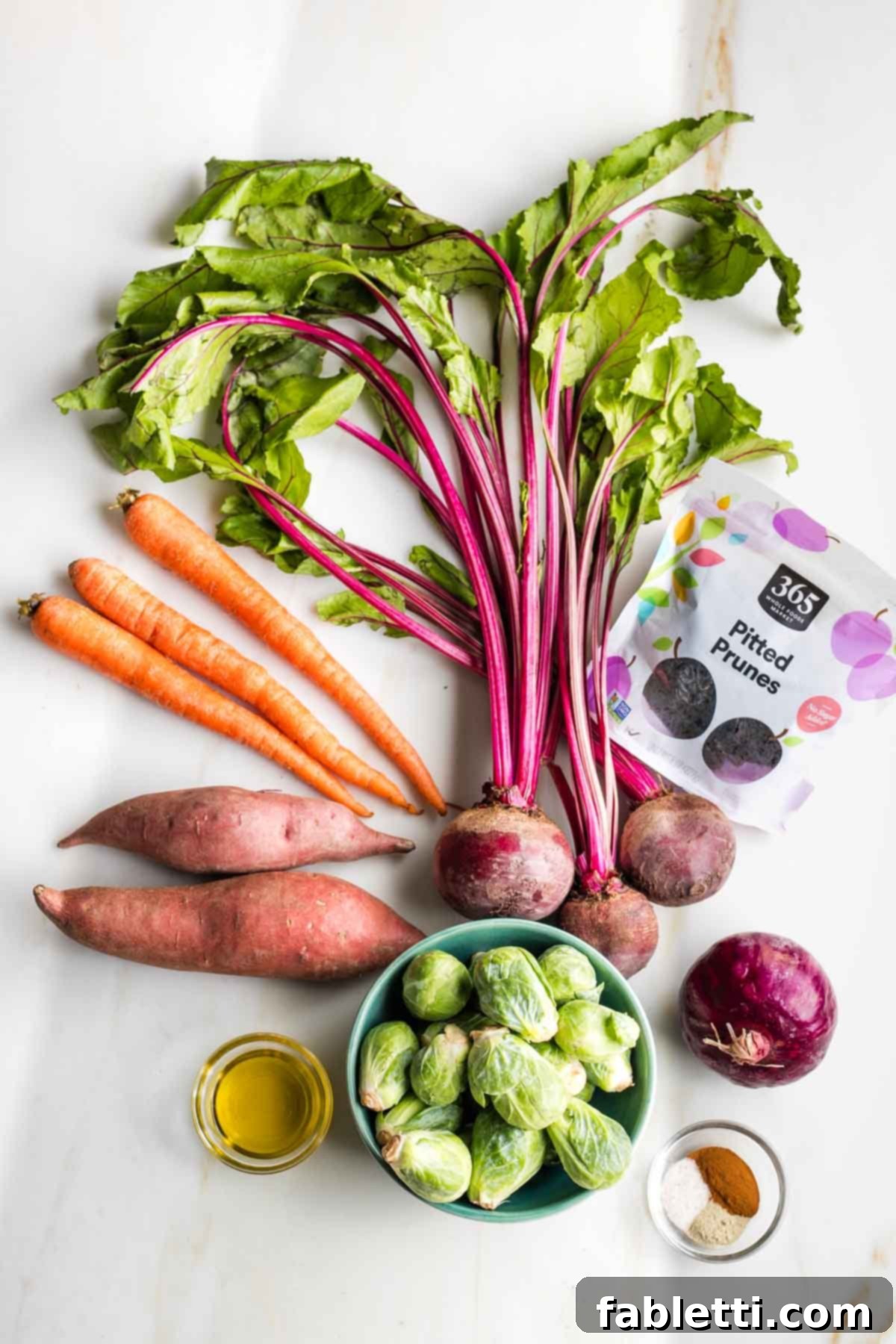
- Carrots: A non-negotiable for me, as my grandmother’s Tzimmes always featured carrots, bringing a nostalgic sweetness and vibrant color. If you’re looking for variation, parsnips or even turnips can be excellent root vegetable substitutes, offering a slightly different earthy sweetness.
- Sweet Potatoes: These provide a creamy texture and deep, natural sweetness that is quintessential to Tzimmes. For an alternative, consider using various winter squashes like butternut, delicata, or acorn squash, peeled and cubed to match the sweet potatoes.
- Beets: While not typically found in classic Tzimmes, I adore the earthy sweetness and stunning ruby-red hue that beets bring to the dish. They add an extra layer of flavor complexity and a beautiful visual appeal that makes the Tzimmes even more inviting.
- Onion: Red onion is my preferred choice for its ability to caramelize beautifully, imparting a robust, savory-sweet depth to the overall flavor profile. A yellow onion works just as well, or for a more delicate flavor, thinly sliced leeks or fennel can be used.
- Brussels Sprouts: Another non-traditional, yet highly recommended, addition. Brussels sprouts introduce a slightly bitter note and a pleasing texture that brilliantly balances the richness and sweetness of the other starchy vegetables, making the dish more dynamic and less heavy.
- Prunes: These soft, naturally sweet dried fruits are a staple in Tzimmes, contributing a wonderful chewiness and concentrated sweetness. Feel free to experiment with other dried fruits such as figs, apricots, or even tart cherries. Always opt for brands that are free from sulfur, added sweeteners, or processed oils to keep it as natural as possible.
- Olive Oil: Extra virgin olive oil helps the vegetables roast and caramelize beautifully. For an oil-free version, you can substitute the olive oil entirely with fresh orange juice or even pineapple juice, which will also add a lovely citrusy or tangy sweetness.
- Spices: A generous amount of cinnamon is crucial here, as it naturally enhances the perceived sweetness of the vegetables and adds a warm, inviting aroma. Just a pinch of kosher salt and a dash of white or black pepper are all that’s needed to round out the flavors and create a perfectly balanced dish.
Step-by-Step Guide: How to Make Easy Sheet Pan Tzimmes
This recipe simplifies the traditional Tzimmes preparation into an efficient and delicious one-sheet-pan method. Follow these steps for a perfect batch every time.
Prep the Vegetables
- Preheat your oven to 425°F (220°C). For even easier cleanup, line a large rimmed baking sheet with unbleached parchment paper.
- For the beets, carrots, and sweet potatoes, there’s no need to peel them if you prefer. Just give them a good scrub with a loofah or a stiff scrub brush to remove any dirt.
- Chop the carrots, onion, sweet potatoes, and beets into small, uniform dice (about ½ to ¾ inch) to ensure even cooking and a consistent texture throughout the dish.
- Trim the ends of the Brussels sprouts, then cut them into quarters, making sure to cut through the core to keep them intact.
- If your prunes are particularly large, cut them into halves or quarters to better distribute their sweetness throughout the Tzimmes.
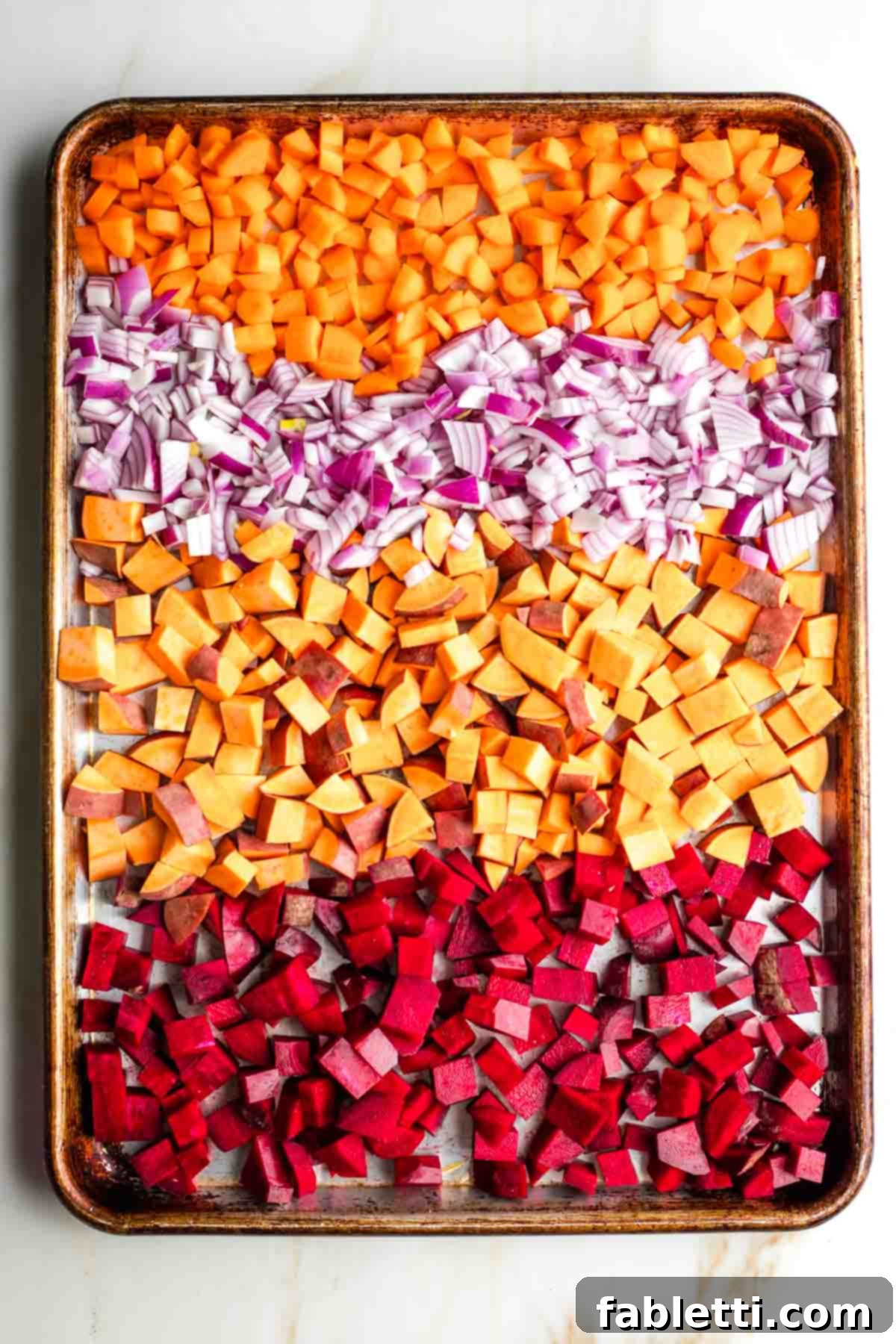
Place the prepped beets, carrots, onions, and sweet potatoes onto your large rimmed baking sheet. Drizzle generously with olive oil (or orange juice for an oil-free option). Toss everything together to ensure the vegetables are evenly coated. Roast in the preheated oven for 10 minutes to give the denser root vegetables a head start on cooking and caramelization.
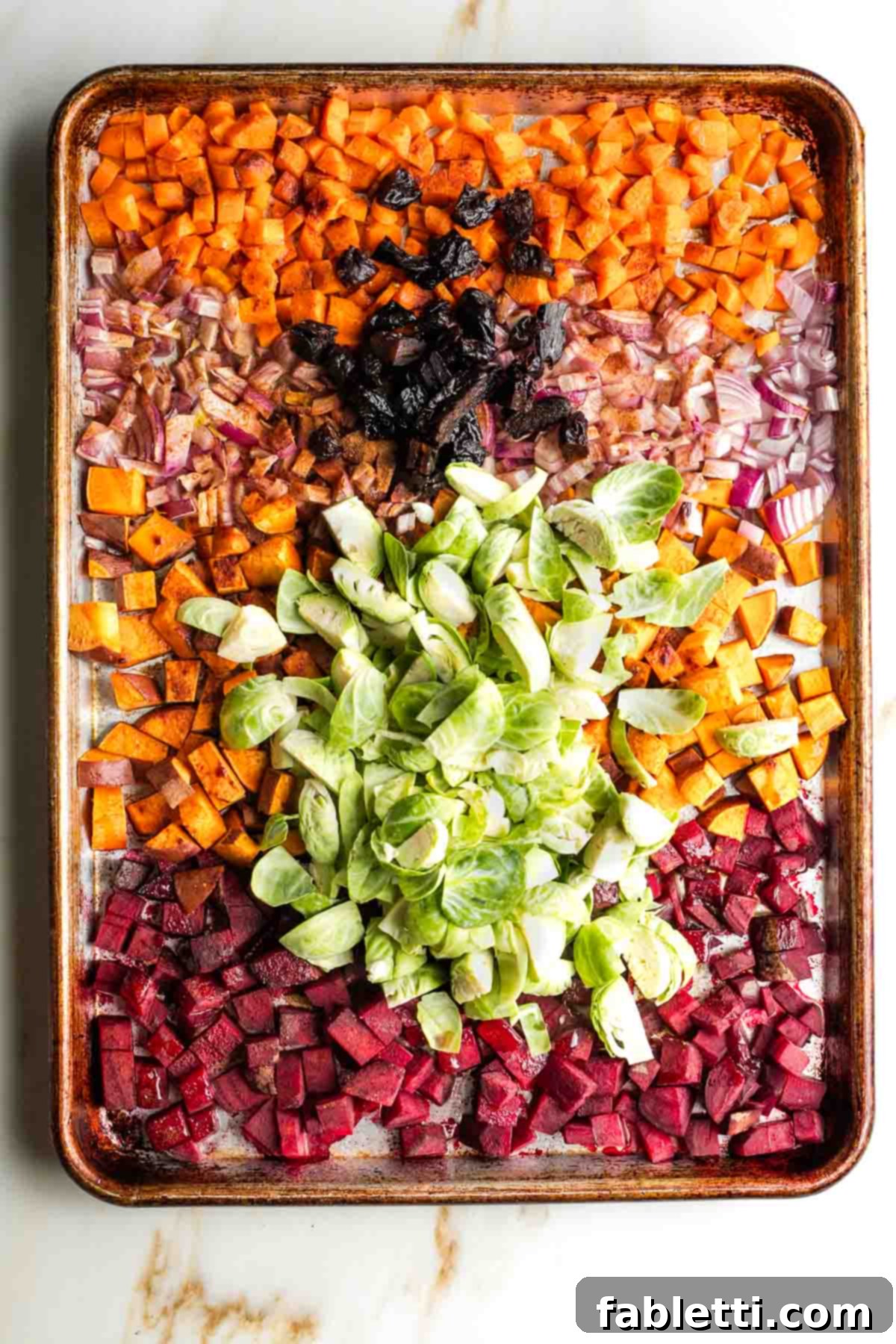
After the initial 10-minute roast, remove the baking sheet from the oven. Sprinkle the vegetable mixture generously with cinnamon, salt, and pepper. Now, add in the prepped Brussels sprouts and prunes. These are added later to prevent the sprouts from overcooking and the prunes from burning, allowing them to soften and release their sweetness perfectly.
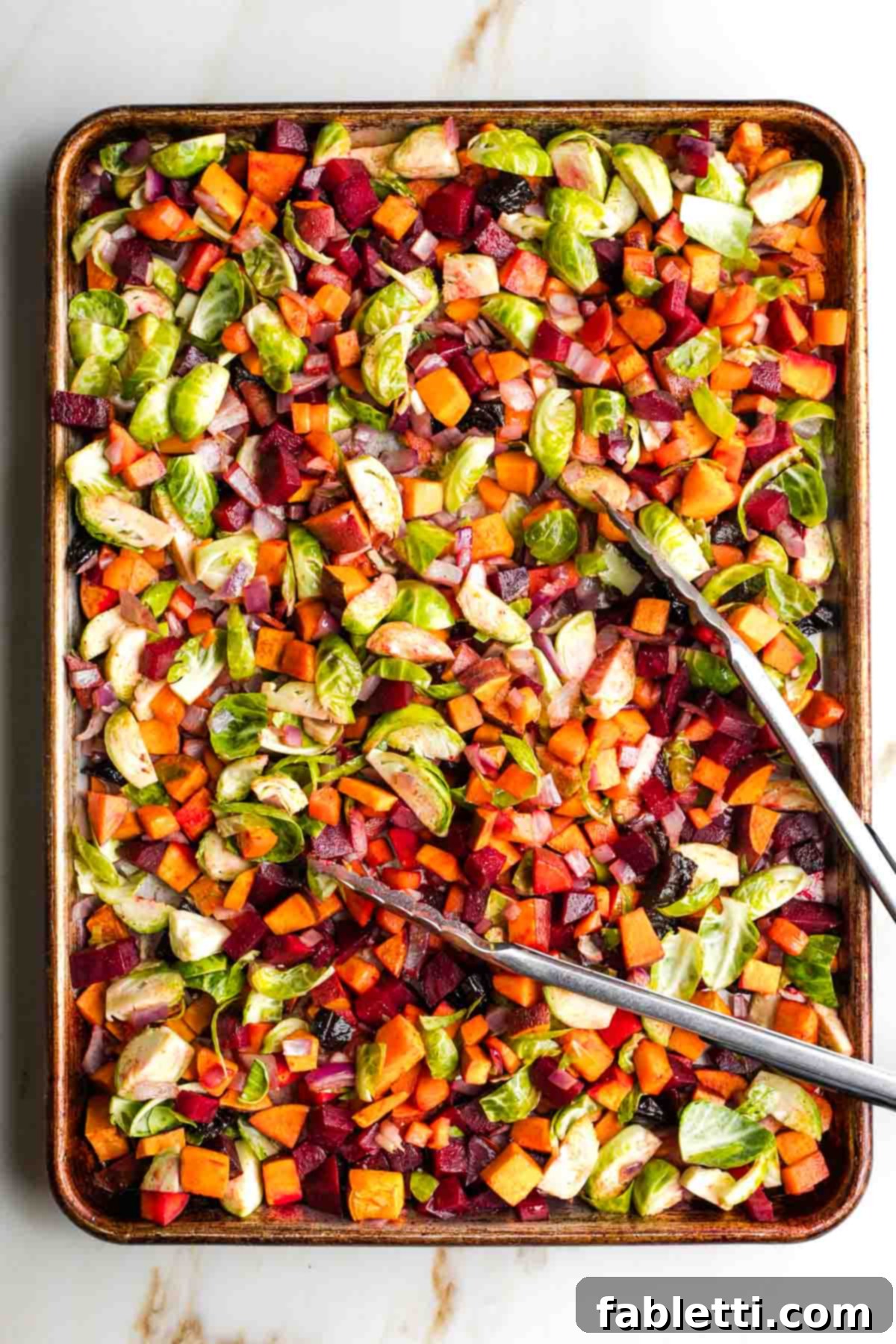
Mix all the ingredients well on the baking sheet, ensuring the new additions are coated with the oil and spices. If the vegetables appear too dry at this stage, add an additional tablespoon of olive oil or a splash of orange or pineapple juice to provide moisture and aid in further caramelization. This extra liquid can also create a light, flavorful glaze.

Return the baking sheet to the oven and continue to roast for another 20 minutes, or until all the vegetables are tender when pierced with a fork and the beets have begun to caramelize beautifully. The sweet potatoes and carrots should be soft, and the Brussels sprouts slightly crisp at the edges. This second stage of roasting allows all the flavors to meld together, creating a rich, complex side dish.
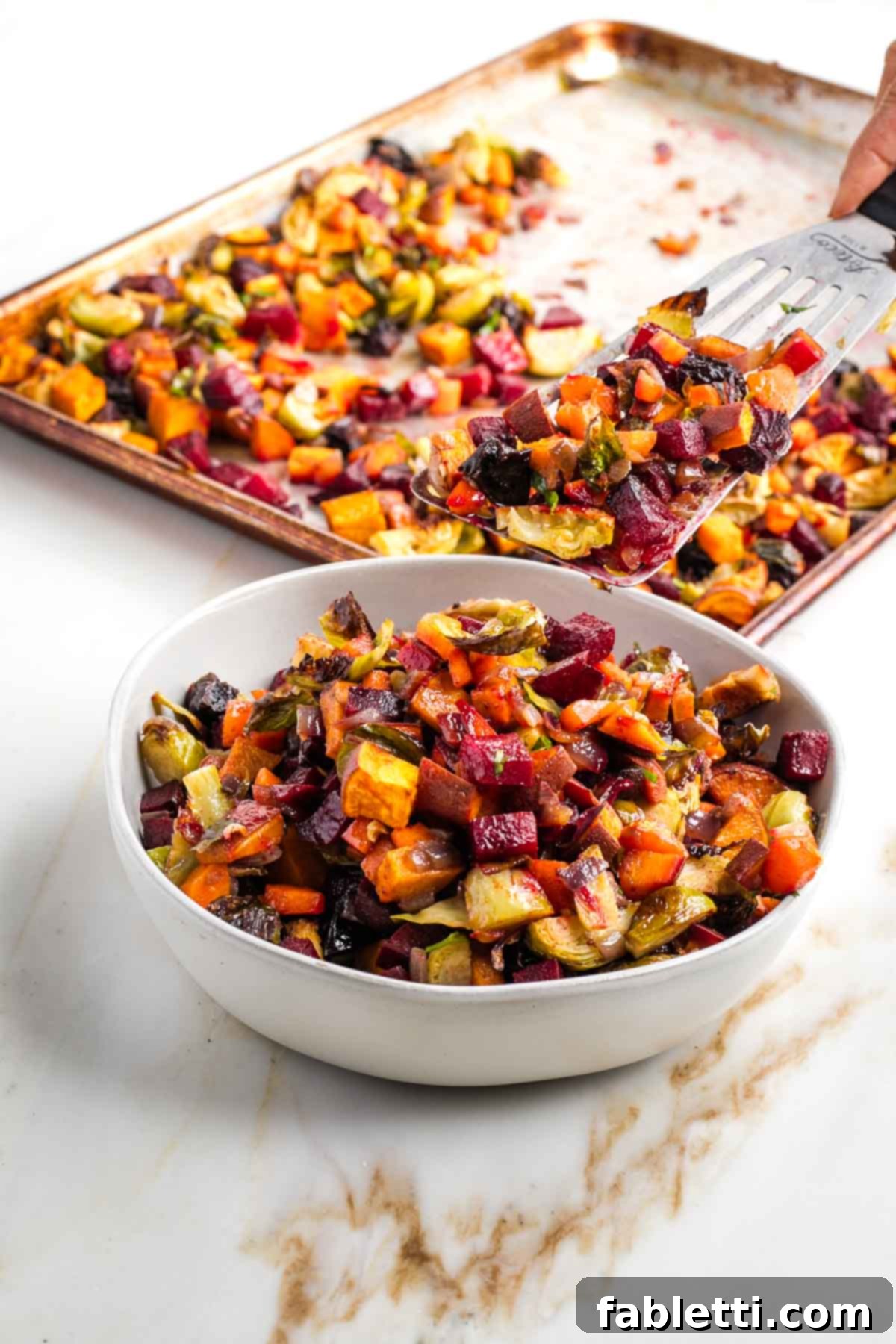
Once roasted to perfection, remove from the oven. This Tzimmes can be served warm, straight from the pan, or at room temperature, making it a versatile dish for any meal. For a final flourish, consider sprinkling with fresh chopped parsley and a hint of orange zest to brighten the flavors.
Debra’s Expert Tips for Tzimmes Perfection
Elevate your Tzimmes with these professional tips and tricks, ensuring every batch is a resounding success.
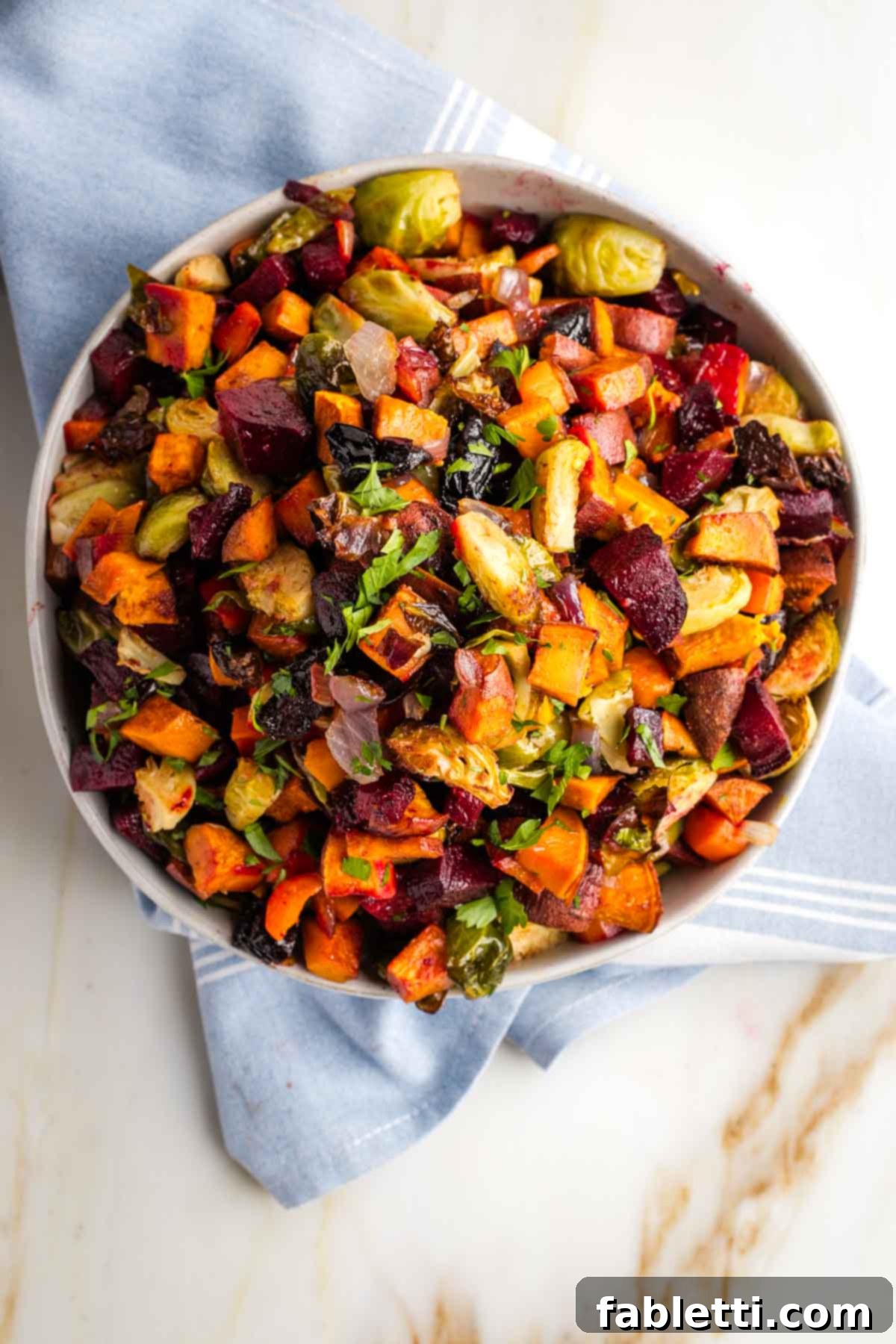
- Add a Touch of Tang: If you prefer your traditional Jewish dish with a bit of a zesty kick, a splash of fresh lemon juice or balsamic vinegar stirred into the finished Tzimmes will add a delightful tanginess that brightens the overall flavor profile.
- Plan for Shrinkage: This is a crowd-pleasing side dish, and root vegetables will naturally shrink significantly during cooking. To ensure you have enough for everyone, always plan accordingly and make a bit extra. It’s better to have leftovers than to run short!
- Handle Beets with Care: Beets can stain hands and cutting surfaces. To minimize this, wear gloves or pierce the beet with a fork to hold it securely while chopping, avoiding direct contact with your hands.
- Perfect Potluck Dish: Tzimmes is an ideal dish to bring to a potluck. Transport it hot in a Dutch oven or a sturdy baking dish. It holds up beautifully and can be served at room temperature, gently reheated in an oven set to any temperature guests are using, or warmed on the stovetop with a splash of orange juice for moisture.
- Flavor Variations: Don’t be afraid to experiment with spices. A hint of ginger, nutmeg, or even a tiny pinch of cloves can add another layer of warmth. For extra brightness, a tablespoon of orange zest tossed with the vegetables before roasting is wonderful.
Make-Ahead & Storage: Enjoying Tzimmes All Week Long
One of the many advantages of this Tzimmes recipe is its excellent make-ahead potential and storage capabilities, allowing you to enjoy this flavorful side dish long after it’s cooked.
- Store: Cooked Tzimmes can be stored in an airtight container in the refrigerator for up to a week. Its flavors often deepen and meld beautifully overnight, making it even more delicious the next day.
- Meal Prep: To get a head start, you can pre-chop all the vegetables except the sweet potatoes. Store each type of vegetable separately in airtight containers in the fridge for up to 2 days before you plan to roast them. Sweet potatoes are best chopped just before cooking to prevent browning.
- Reheat: To reheat, simply place the Tzimmes in a 2-quart baking dish, cover loosely with foil, and bake at 350°F (175°C) for about 20 minutes, or until heated through. Alternatively, warm it gently in a saucepan on the stovetop over medium heat, adding a couple of tablespoons of fruit juice (like orange or apple) to prevent it from drying out.
- Freeze: Tzimmes freezes exceptionally well. Allow it to cool completely, then transfer it to freezer-safe containers or zip-top bags. It can be frozen for up to 3 months. To serve, defrost in the refrigerator overnight or at room temperature, then reheat as directed above.
When to Serve Tzimmes: From Holiday Feast to Weeknight Delight
The beauty of this easy Tzimmes recipe lies in its incredible versatility. While it’s a beloved staple for Jewish holiday meals, its quick preparation time and hands-off cooking make it suitable for a variety of occasions.
With just minutes of prep and 30 minutes of total roasting time, this Tzimmes truly shines as an awesome weeknight side dish. It pairs perfectly with almost any main course, effortlessly elevating a simple meal. For those busy evenings when you crave something wholesome and flavorful without the culinary gymnastics, this recipe is a lifesaver.
Of course, this traditional Ashkenazi Jewish side dish is perfectly at home on any holiday buffet. I regularly feature this Tzimmes for Rosh Hashanah, symbolizing a sweet new year, and also for Passover, where its natural sweetness complements the Seder plate. Jewish holiday food like Tzimmes is more than just sustenance; it’s comforting, deeply nostalgic, and incredibly nourishing, connecting us to generations past and present.
Enjoy the holiday with friends and family. This Tzimmes recipe is designed to help you relax and savor the moments, allowing you to focus on telling the timeless stories that have been shared for countless generations, and hopefully, will continue for many more to come. No need to make a “big tzimmes” over dinner when you have this easy recipe in your repertoire!
More Beloved Jewish Holiday Recipes to Complete Your Feast
- Dairy-free Apple Noodle Kugel Recipe
- Cauliflower Kugel Recipe
- Vegetarian Chopped Liver Recipe with Mushrooms
- Vegan Stuffed Cabbage Rolls
Did you know commenting and rating recipes is one of the best ways to support your favorite food bloggers? If you made this recipe, please consider a five-star rating below and leave a comment. Also, please share your photos on Instagram by tagging me @dkhealthcoach and using the hashtag #debraklein
📖 Recipe
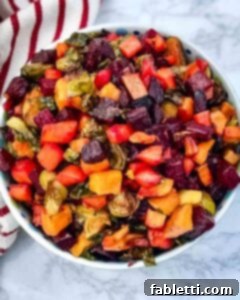
The BEST Tzimmes Recipe
Pin Recipe
Equipment
- Half Sheet Baking Pans
- Chef’s knife
- Extra Large Bamboo Cutting Board
Ingredients
- 1 lb. beets about 3 large
- 1 lb carrots about 3 large or 4 medium
- 1 lb. Brussels sprouts
- 1 lb. sweet potatoes 2 medium-large
- 1 red onion
- 2 tablespoon olive oil extra virgin
- 1 teaspoon cinnamon
- ½ tsp sea salt
- ½ teaspoon white pepper
- ¼ cup prunes cut into ¼s
Instructions
- Preheat oven to 425°F (220°C) and line a large rimmed baking tray with unbleached parchment paper if desired for easier clean up.
- Prep Veggies: Use a loofah or scrub brush to wash the beets, carrots, and sweet potatoes. Peeling is optional; I often skip it for added nutrients and texture. Chop beets, carrots, onions, and sweet potatoes into large dice (about ½ to ¾ inch cubes). Wash and trim Brussels sprouts and cut them into pieces similar in size to the diced veggies, quartering them through the core.
- Place the diced beets, carrots, onions, and sweet potatoes onto the prepared pan. Drizzle with olive oil, then sprinkle generously with cinnamon, salt, and pepper. Toss everything well to ensure an even coating of oil and spices on all the vegetables.
- Roast the vegetables in the preheated oven at 425°F (220°C) for 10 minutes. After 10 minutes, remove the pan from the oven. Add the Brussels sprouts and prunes to the pan and mix well with the other vegetables. If the veggies appear dry, sprinkle on an additional tablespoon of olive oil, or use a splash of orange or pineapple juice to add moisture and flavor. Continue to cook for another 20 minutes, or until all vegetables are tender when pierced with a fork and the beets have begun to caramelize around the edges.
- Tzimmes can be enjoyed immediately or made in advance. If making ahead, store it in an airtight container in the fridge and gently reheat in a 325°F (160°C) oven until warmed through. It can also be served deliciously at room temperature.
Notes
STORAGE: Store cooked tzimmes in an airtight container in the fridge for up to a week. It also freezes well for up to 3 months.
Nutrition
Note
The nutrition calculations were done using online tools. To obtain the most accurate representation of the nutritional information in any given recipe, you should calculate the nutritional information with the actual ingredients you used. You are ultimately responsible for ensuring that any nutritional information is accurate, complete and useful.
